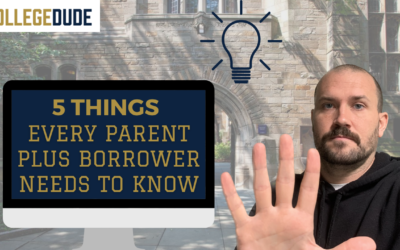As the federal student loan payment pause officially draws to a close, it becomes crucial to assess your upcoming monthly financial commitments. For those with Parent PLUS loans, there’s an added layer of importance in ensuring that your retirement planning remains on track. With loan payments resuming today, it’s essential to navigate the intersection of retirement planning with Parent PLUS loans effectively.
Parent PLUS Loan Introduction
Parent PLUS loans are one of the loan options of the federal student loan system. These loans are disbursed directly by the Department of Education and are serviced by various entities designated by the federal government. Parent PLUS loans come with specific protections offered through the federal student loan system. These protections include the potential eligibility for income-driven repayment plans and qualification for public service loan forgiveness. There are also benefits like the COVID forbearance that has been in effect for the past three and a half years. These aspects make Parent PLUS loans a popular choice to pay for college. They become especially important as we navigate the transition back to regular loan payments.
As we approach the end of the federal student loan payment pause, it’s crucial to ensure that if you’re planning to resume repayments on your Parent PLUS loans, you’re following the most effective strategy while simultaneously safeguarding your retirement goals.
Many parents who initially took out Parent PLUS loans may not have fully comprehended the overall loan balance they’d be facing. They were also likely not adequately informed about repayment strategies. Consequently, the actual monthly repayment amount can catch you by surprise. It underscores the importance of ensuring that your monthly repayment is manageable within your budget while also maintaining your retirement savings on track. Balancing these financial aspects is key to securing your financial future as the repayment pause has officially ended.
Repayment Plan Options
You may or may not be aware that Parent PLUS Loan borrowers have access to a variety of repayment plans. Among them, the two most commonly used are the standard and graduated repayment plans, often chosen when parents haven’t explored income-driven repayment options.
The standard repayment plan spans a 10-year period, with the average interest amount amortized evenly over these years. This means you’ll be making fixed monthly payments for a decade until the loan is fully paid off.
On the other hand, the graduated repayment plan starts with lower payments in the initial years and gradually increases them every two years. While this approach may result in paying more interest over the life of the loan, it offers flexibility in budgeting, making it easier to manage your finances as your income potentially grows over time. These repayment options allow you to tailor your repayment strategy to your specific financial circumstances and goals.
Income-Driven Repayment Plans
Among the more favored methods for repaying Parent PLUS loans are the federal income-driven repayment plans. One strategy to explore is the double consolidation approach, which we covered in a recent video.
Currently, there’s some debate regarding the status of this strategy and whether it remains in effect. However, what we can confirm is that you are eligible for the income-contingent repayment plan, at the very least. If the double loan consolidation strategy is still viable, it provides you with flexibility to choose from various repayment plans that suit your financial circumstances and objectives. Staying informed about these options is essential as you navigate the transition back to loan repayments.
Another option available to Parent PLUS loan borrowers is the income-contingent repayment plan. To grasp how the income-contingent plan functions, it’s crucial to understand that it’s tied to the income of the Parent PLUS loan borrower.
One major factor to consider is the annual income of the parent who has taken on the Parent PLUS loan. If a parent is on an income-driven repayment plan, it directly impacts the required repayment amount.
Forgiveness Options
If the borrower works for a qualifying employer, Public Service Loan Forgiveness could be an option. This benefit is an intriguing one for public employees. 120 qualifying payments, and the loan balance is forgiven, tax-free!
Additionally, you should keep in mind that there are standard forgiveness options available. For instance, if you’re on the income-contingent repayment plan, after 25 years of qualifying repayments, your remaining balance can be forgiven. It’s important to note that there may be taxable implications associated with this forgiveness. While much could change over the next 25 years, we must understand the rules written as of today.
Under the current rules, the forgiven amount after 25 years would be treated as taxable income. This means that the forgiven portion would be reported on your tax return as taxable income. You would owe taxes on that amount based on your marginal income tax bracket.
This tax implication underscores the importance of calculating your estimated monthly payment under your chosen repayment plan. By doing so, you can make a direct comparison between your expected monthly loan payment, your retirement savings, and your overall cash flow. Regrettably, some parents do enter retirement carrying debt, and it’s crucial to plan accordingly to ensure financial stability during your retirement years.
The Tax Planning You Should Consider
In light of this, it becomes imperative to budget wisely. Ensuring that you are enrolled in a lower repayment plan, particularly one that is tied to your income, can offer more financial flexibility within your budget.
You should recognize that the specific repayment plan you qualify for will depend on various factors. This includes your income, tax filing status, household size, and the loan amount you’ve borrowed. Additionally, eligibility for public service loan forgiveness may come into play. These variables must be considered when planning for retirement.
Guaranteed Income
When it comes to retirement planning, the goal is to have a strategy in place for converting assets into income. Some parents may be fortunate enough to have a pension or be in a public service job that provides a pension. Many individuals will also be eligible for Social Security benefits. Tailoring your retirement plan to your unique financial situation and considering these various income sources is key to securing a comfortable retirement.
Indeed, both Social Security and pensions, provided they remain intact, offer the assurance of a lifelong guaranteed income. However, it’s crucial to understand the specifics of the credit system employed by your pension provider to ensure you make the most of these benefits.
Once you’ve accounted for Social Security and pension income, the next step typically involves assessing your retirement savings. Many individuals have funds stashed away in vehicles like 401(k)s, Roth IRAs, and the like. Transforming these assets into a reliable income source becomes vital during retirement. Establishing an income plan allows you to determine how much you can safely withdraw while still managing your obligations, including repaying Parent PLUS loans. Planning ahead in this way helps ensure your financial stability in retirement.
Considerations for Retirement Plans
When it comes to managing a Parent PLUS loan in retirement, two significant factors demand your attention. Effective tax planning becomes paramount in this scenario. The first consideration is if you’re still working and planning to retire while carrying a Parent PLUS loan. In such cases, there are retirement accounts available that allow you to make contributions, thereby reducing your adjusted gross income. This reduction, in turn, can lower your monthly payments under an income-driven repayment plan.
For those enrolled in an income-driven repayment plan, the loan servicer assesses your adjusted gross income. The lower your adjusted gross income, the smaller your monthly repayment obligation. Strategically using retirement accounts to lower your income can be a powerful tool in managing your Parent PLUS loan during retirement and maintaining financial stability.
Reducing your income on your tax return can indeed lead to lower monthly payments on your student loans. Contributions to tax-advantaged retirement accounts like 401(k)s, IRAs, and HSAs can provide pre-tax deductions, effectively decreasing your taxable income. This, in turn, has a positive impact on your monthly student loan repayments while simultaneously boosting your retirement savings.
Utilizing After-Tax Accounts
In retirement, there’s another valuable strategy to consider. You can utilize after-tax accounts to supplement your income. If you have assets in a Roth IRA or an after-tax account with a substantial cost basis, you can tap into these accounts to generate additional income as needed. This approach allows you to coordinate your financial resources to cover your expenses during retirement, including any outstanding Parent PLUS loan payments.
If you use after-tax accounts strategically, you can declare untaxed income. This avoids an increase in your adjusted gross income. This can include after-tax accounts that are a return of basis, or qualified Roth withdrawals. However, it’s essential to understand that the specific rules governing these accounts can vary, and this strategy may require some planning.
By tapping into these after-tax accounts as a source of income, you can effectively lower your adjusted gross income, which, in turn, reduces your Parent PLUS loan repayment amount if you’re on an income-driven repayment plan. Leveraging these accounts can have a dual benefit of lowering your repayment obligation while potentially increasing the amount you may be eligible for in terms of loan forgiveness. It’s a valuable approach to optimize your financial situation during retirement while managing your Parent PLUS loan responsibly.
Planning is Critical
Debt planning, insurance planning, retirement planning, investment planning, and tax planning are often interconnected aspects of your financial well-being. Recognizing these interrelations is crucial, and seeking professional guidance is a prudent step to navigate them effectively. Working with a financial professional can provide valuable insights into reducing monthly loan payments while simultaneously bolstering your retirement savings.
The ultimate aim is to ensure your financial goals are met. Achieving this requires a holistic approach, and sometimes, expert assistance may be necessary. It’s essential to grasp how different accounts and repayment plans function and how they can complement each other to optimize your overall financial efficiency. By aligning these plans, you can work toward maximizing your financial well-being and securing a comfortable future. To properly go about retirement planning with Parent PLUS loans is usually a lengthy process. But when done properly, it can allow parents to see their child get off to a great start and keep on track for retirement.
As always, it’s important to clarify that this information is provided for educational purposes and is not intended as personalized advice for any specific individual. If you have questions or require guidance related to student loan repayments, retirement planning, or any other financial matters, it’s highly advisable to consult with professionals such as your CPA, tax preparer, financial planner, or tax attorney. They can offer personalized insights tailored to your unique circumstances.






